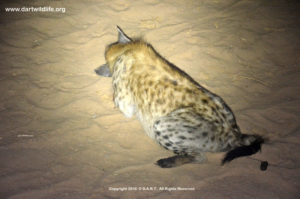
While investigating the carcass of a dead elephant in the Guvalala Pan area we noticed what appeared to be a snare around the neck of a hyena that was lying in the waterhole to cool down during the heat of the day. It was difficult to be certain it was a snare because the mud had obscured visibility around the neck area and the hyena ran off before we could get close enough to confirm.
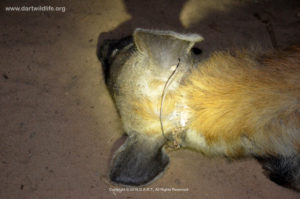
It seems that the adult female elephant had died a natural death probably as a result of old age compounded by lack of adequate food as well as heat stress due to the soaring ambient temperatures. Her death however had provided an ideal “bait” to attract hyenas and hopefully an opportunity to find and dart the animal with the snare.
With the help of Ranger Antonio we returned after dark to try to find the unfortunate hyena. It is difficult and dangerous to dart a free-ranging wild hyena. Hyenas are incredibly intelligent and seem capable of quickly differentiating between a harmless photographic tourist and a person trying to shoot darts at them. Once they realize your intention they keep their distance and stay out of range of the dart rifle making it almost impossible to get close enough for the shot. If you are fortunate enough to get a dart in, the hyena will generally take off at a run for the 4-6 minutes it takes before the immobilizing drug takes effect. During this time the well-camouflaged and fast disappearing backside of a hyena can be exceptionally difficult to follow at night with a spotlight and binoculars as the animal races through long grass and scrub vegetation. Any attempt to follow the fleeing animal in a vehicle only serves to speed up the chase.
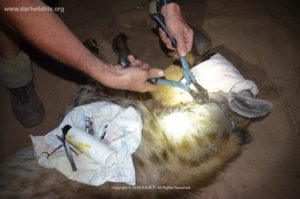
For this reason the vast, open stretches of Kalahari sands surrounding Guvalala Pan with such open visibility at this time of the year provided a perfect landscape for this darting operation.
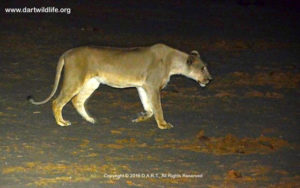
The next important considerations were for the security of the darting team and the safety of the immobilized hyena. These concerns were validated soon after the sun had set and herd after herd of thirsty elephants materialized from the darkness and silently made their way down to the Pan to drink. In no time there were more than 100 elephants drinking, wallowing in the mud and milling about in the open area around the Pan. If this danger wasn’t enough, a lioness also appeared for a drink of water and wandered around the Pan for some time before disappearing into the surrounding tree line.
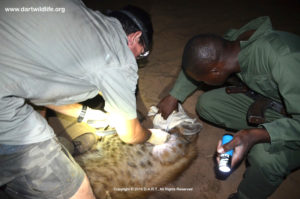
After carefully weighing up all these risks and safety concerns the snared hyena suddenly came into range and without hesitation a light plastic Daninjet dart was dispatched and lodged gently into her exposed shoulder.
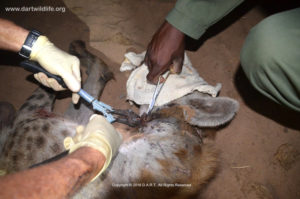
The snare wound was an old one that had healed almost completely around the neck except for a few areas where the buried steel wire was still protruding out of the skin. It took some time to delicately cut and remove the snare from under the skin and clean the wound.
Many people might think it crazy to work until midnight on Sunday evening in a dark and remote area of the Park near an elephant carcass surrounded by an unknown number of lions, 17 hyenas and more than 100 elephants but for us it was a privilege. Despite receiving a number of very close visits from curious hyenas and inquisitive elephants throughout the evening they were never aggressive and it was only while treating this immobilized hyena that we experienced how gentle and understanding all these wild animals can be. We never once felt threatened and we soon learned that their approaches could easily be deterred with a few gentle and respectful words…. Fortunately we never had to try this on the lioness, as she didn’t reappear.
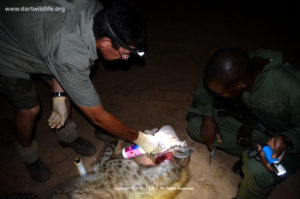
The entire operation was carried out without disruption and the hyena woke up soon after the antidote was administered. She immediately ran off with members of her clan to continue feeding on the elephant carcass.
As is often the case when darting carnivores, this hyena chewed up and destroyed our Daninject dart and needle. These essential pieces of equipment need to be replaced as soon as possible but this is easier said than done as they’re not available in Zimbabwe and will have to be sourced in South Africa.
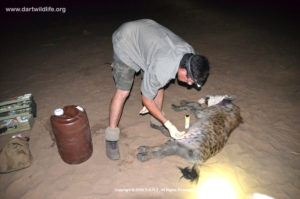
We extend grateful thanks once again to the Friends of Hwange Trust and the Hwange Conservation Society (UK) for kindly providing the wildlife immobilizing drugs and necessary wound cleaning solutions used.
Paul and Stéphanie de Montille